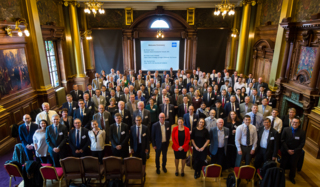Related Research Articles

The International Organization for Standardization is an independent, non-governmental, international standard development organization composed of representatives from the national standards organizations of member countries. Membership requirements are given in Article 3 of the ISO Statutes.
Conformance testing — an element of conformity assessment, and also known as compliance testing, or type testing — is testing or other activities that determine whether a process, product, or service complies with the requirements of a specification, technical standard, contract, or regulation. Testing is often either logical testing or physical testing. The test procedures may involve other criteria from mathematical testing or chemical testing. Beyond simple conformance, other requirements for efficiency, interoperability, or compliance may apply. Conformance testing may be undertaken by the producer of the product or service being assessed, by a user, or by an accredited independent organization, which can sometimes be the author of the standard being used. When testing is accompanied by certification, the products or services may then be advertised as being certified in compliance with the referred technical standard. Manufacturers and suppliers of products and services rely on such certification including listing on the certification body's website, to assure quality to the end user and that competing suppliers are on the same level.
ISO/IEC 15504Information technology – Process assessment, also termed Software Process Improvement and Capability dEtermination (SPICE), is a set of technical standards documents for the computer software development process and related business management functions. It is one of the joint International Organization for Standardization (ISO) and International Electrotechnical Commission (IEC) standards, which was developed by the ISO and IEC joint subcommittee, ISO/IEC JTC 1/SC 7.
IEC 61850 is an international standard defining communication protocols for intelligent electronic devices at electrical substations. It is a part of the International Electrotechnical Commission's (IEC) Technical Committee 57 reference architecture for electric power systems. The abstract data models defined in IEC 61850 can be mapped to a number of protocols. Current mappings in the standard are to Manufacturing Message Specification (MMS), GOOSE [see section 3, Terms and definitions, term 3.65 on page 14], SV or SMV, and soon to web services. In the previous version of the standard, GOOSE stood for "Generic Object Oriented Substation Event", but this old definition is still very common in IEC 61850 documentation. These protocols can run over TCP/IP networks or substation LANs using high speed switched Ethernet to obtain the necessary response times below four milliseconds for protective relaying.
ISO/IEC 20000 is the international standard for IT service management. It was developed in 2005 by ISO/IEC JTC1/SC7 and revised in 2011 and 2018. It was originally based on the earlier BS 15000 that was developed by BSI Group.
The ISO/IEC 27000-series comprises information security standards published jointly by the International Organization for Standardization (ISO) and the International Electrotechnical Commission (IEC).
ISO/IEC 27001 is an international standard to manage information security. The standard was originally published jointly by the International Organization for Standardization (ISO) and the International Electrotechnical Commission (IEC) in 2005, revised in 2013, and again most recently in 2022. There are also numerous recognized national variants of the standard. It details requirements for establishing, implementing, maintaining and continually improving an information security management system (ISMS) – the aim of which is to help organizations make the information assets they hold more secure. Organizations that meet the standard's requirements can choose to be certified by an accredited certification body following successful completion of an audit. A SWOT analysis of the ISO/IEC 27001 certification process was conducted in 2020.

ISO/TC 292 Security and resilience is a technical committee of the International Organization for Standardization formed in 2015 to develop standards in the area of security and resilience.
References
- ↑ "ISO - ICS". ISO. Retrieved 2024-06-14.
- ↑ "Publicly Available Standards". standards.iso.org. Retrieved 2024-06-14.
- ↑ ISO, ISO/IEC 17050-1:2004 Conformity assessment — Supplier's declaration of conformity — Part 1: General requirements, accessed 2 July 2020
- ↑ ISO, ISO/IEC 17050-2:2004 Conformity assessment — Supplier's declaration of conformity — Part 2: Supporting documentation, accessed 2 July 2020
- ↑ ISO, ISO 17712:2103: Freight containers — Mechanical seals, accessed 6 December 2020
- ↑ Mega Fortis Group, What exactly is an ISO 17712 Certified or a C-TPAT “Compliant” Security Seal?, published 6 November 2017, accessed 6 December 2020